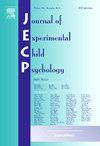Do children match described probabilities? The sampling hypothesis applied to repeated risky choice
IF 1.8
2区 心理学
Q3 PSYCHOLOGY, DEVELOPMENTAL
引用次数: 0
Abstract
One way in which children can learn about probabilities of different outcomes before making a decision is from description, for instance, by observing graphical representations of frequency distributions. But how do repeated risky choices develop in early childhood when outcome probabilities are learned from description? Integrating previous findings from children’s sampling processes in causal learning and adults’ repeated choice behavior, we investigated repeated choices from 201 children aged 3 to 7 years and 100 adults in a child-friendly risky choice task. We expected young children to probability match and predicted that the perceived dependency between choices would shape the underlying choice process. However, the assumed cognitive processes derived from the causal learning and risky choice literature did not generalize to children’s or adults’ repeated risky choices when outcome probabilities were learned from graphical representations prior to making a decision. Moreover, choice behavior did not differ as a function of the perceived dependency between guesses. Instead, children broadly diversified choices, and switching between options dominated older children’s choice behavior. Our results contribute to increasing evidence of childhood as a phase for heightened exploration and highlight the importance of considering the learning format when studying repeated choice across development.
孩子是否符合描述的概率?抽样假设适用于重复的风险选择。
孩子们在做出决定之前了解不同结果的概率的一种方法是通过描述,例如,通过观察频率分布的图形表示。但是,当结果的可能性是通过描述来学习的时候,在儿童早期,重复的冒险选择是如何发展的呢?结合前人关于儿童因果学习抽样过程和成人重复选择行为的研究结果,我们对201名3 - 7岁儿童和100名成人在儿童友好型风险选择任务中的重复选择进行了研究。我们期望幼儿概率匹配,并预测选择之间的感知依赖性会影响潜在的选择过程。然而,从因果学习和风险选择文献中得出的假设认知过程并不能推广到儿童或成人在做出决定之前从图形表示中了解结果概率时的重复风险选择。此外,选择行为并没有因为猜测之间的感知依赖性而有所不同。相反,孩子们的选择范围很广,在选项之间切换主导着大孩子的选择行为。我们的研究结果提供了更多的证据,证明童年是一个高度探索的阶段,并强调了在研究跨越发展的重复选择时考虑学习形式的重要性。
本文章由计算机程序翻译,如有差异,请以英文原文为准。
求助全文
约1分钟内获得全文
求助全文
来源期刊

Journal of Experimental Child Psychology
Multiple-
CiteScore
4.50
自引率
7.70%
发文量
190
期刊介绍:
The Journal of Experimental Child Psychology is an excellent source of information concerning all aspects of the development of children. It includes empirical psychological research on cognitive, social/emotional, and physical development. In addition, the journal periodically publishes Special Topic issues.
 求助内容:
求助内容: 应助结果提醒方式:
应助结果提醒方式:


